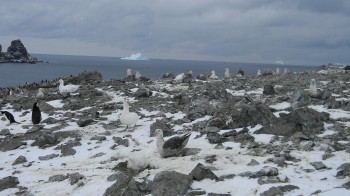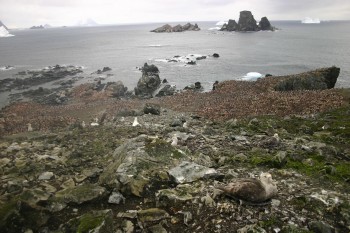Laurie Island is the second largest and easternmost of themaritime Antarctic South Orkney Islands (after Coronation Island). The island group lies south of 60°S and thus falls within the area of the Antarctic Treaty (where national claims to territory remain frozen). The seas around the South Orkneys are ice-covered from late April to November.
Cape Geddes and Watson Peninsula, situated on the northern coast of the mainly ice-covered island, both support breeding groups of Southern Giant Petrels Macronectes giganteus making their nests on ice-free ground. Overall, 419 breeding pairs were counted on Laurie Island in the 1994/95 season, 467 pairs in 2005/06 and 624 in 2010/11, suggesting a population increase over time.
Cape Geddes
Southern Giant Petrels breed in scattered groups of varying sizes at Cape Geddes. The species was first reported breeding at the locality in 1908 when the species was described as abundant. Two hundred nests were reported for 1946. Totals of 159 active nests were counted during the 1985/86 season, 162 nests in 1991/92, 228 in January 1994 (1993/94), 184 in 1994/95 and 187 in 2005/06.


Cape Geddes falls within the 113-ha Ferguslie Peninsula Important Bird Area (IBA), because of its large numbers of breeding Chinstrap Penguins Pygoscelis antarctica.



Watson Peninsula
Estimates or counts of Southern Giant Petrels have been reported for 1904 (100 pairs?), 1993/04 (230 active nests), 1994/95 (235 active nests) and 280 pairs in 2005/06. The peninsula has also been categorized as an IBA with an area of 187 ha because of its large Chinstrap Penguin population.
The Argentinean research station Orcadas Base lies 9 km to the south-west of Cape Geddes; it is the oldest permanently inhabited base in the Antarctic region, established in 1904.
Click here for the ACAP Breeding Site account for Signy Island in the South Orkneys where 2351 pairs bred in 2005/06.
With thanks to Néstor Coria for information and for photographs of the giant petrel colonies at Cape Geddes.
Selected References:
Coria, N.R., Blendinger, P.G. & Montalti, D. 1996. The breeding birds of Cape Geddes, Laurie Island, South Orkney Islands, Antarctica. Marine Ornithology 24: 43-44.
Coria, N.R., Montalti, D., Rombola, E.F., Santos, M.M., Garcia Betoño, M.I. & Juares, M.A. 2011. Birds at Laurie Island, South Orkney Islands, Antarctica: breeding species and their distribution. Marine Ornithology 39: 207-213.
Harris, C.M., Carr, R., Lorenz, K. & Jones, S. 2011. Important Bird Areas in Antarctica: Antarctic Peninsula, South Shetland Islands, South Orkney Islands - Final Report. Cambridge: Environmental Research & Assessment Ltd. 225 pp.
Patterson, D.L., Woehler, E.J., Croxall, J.P., Cooper, J., Poncet, S., Peter, H.-U., Hunter, S. & Fraser, W.R. 2008. Breeding distribution and population status of the Northern Giant Petrel Macronectes halli and Southern Giant Petrel M. giganteus. Marine Ornithology 36: 115-124.
Click here for the paper's separate appendices with historical count data.
Shirihai, H. 2007. A Complete Guide to Antarctic Wildlife. The Birds and Marine Mammals of the Antarctic Continent and the Southern Ocean. London: A & C Black. pp. 447-449.
John Cooper, ACAP Information Officer, 01 December 2013

 English
English  Français
Français  Español
Español